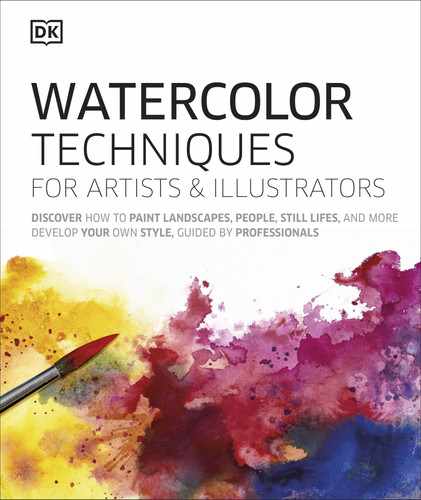
234 Portraits, figures, and animals | SUBJECTS
PUTTING IT INTO PRACTICE
In this view, the gures are
part of the landscape, adding
incidental detail to the overall
composition. Similar colors and
tones from the sea and land help
the gures blend with other
elements without distraction.
Incidental gures
PORTRAYING FIGURES IN A LANDSCAPE
Figures naturally tend to demand our attention and
can dominate a scene. For landscapes, all elements should
blend to a harmonious whole. Through careful planning
and color choices, you can subdue the impact of gures
in various ways to create a balanced composition.
Integrating gures
It is easy to make gures in
a landscape too prominent.
Remember you are painting a
landscape that happens to have
gures, not a gure study with a
landscape; the gures must blend
with the other elements. Try to
connect and harmonize the gure
with the landscape by merging
edges and repeating colors.
Seafront
No. 14 soft-hair round brush
No. 10 soft-hair mop brush
10 x 14 in (25 x 35 cm) cold press
140 lb (300 gsm) watercolor paper
You will need
1
All-over wash
Paint a blending background wash
from top to bottom. Use a mix of phthalo
blue with a touch of quinacridone
magenta for the sky and sea, and a warm
mix of quinacridone magenta and azo
yellow for the land. Do not leave space
for the gures; nothing is more isolating
than a hard edge around every gure.
2
Blend gures to background
Start to gradually dene the elements
with the second wash, warming the
middle ground with cadmium yellow.
Use similar tonal values for the gures,
carrying touches of burnt sienna in the
landscape to create visual connections.
Allow some of the
gures to partly blend
with the background
French
ultramarine
Quinacridone
magenta
Cadmium red
Phthalo
blue (green
shade)
Cadmium
yellow
Azo yellow
Burnt sienna
US_234-235_Figures_in_landscape.indd 234 02/04/2020 3:35pm

235 Incidental figures
3
Connect colors
Repeat every color in the landscape
in the gures (and vice versa) to create
harmony. Here, the stronger greens and
browns of the palm trees link to the
clothing in the gures beneath.
4
Tonal balance
Continue to strengthen all colors,
adding darks here and there with dots
and dashes to create tonal interest.
Treat the gures with no more
importance than the trees or buildings,
using similar tones and color.
A few light clouds break up
the sky wash and balance
the composition
The same mix of phthalo blue and
cadmium red is used to link all
mid and foreground shadows
Blend the lower legs with
the shadows to anchor
the gure to the ground
Repeating colors
Try to integrate gures into the rest of the landscape by using the local
color for both, and if you must use a strong color such as red in your
gure, include it in the landscape, too, to lessen the visual effect.
Blending in
White space or painting a hard edge around a gure will immediately
isolate them, as if spotlit. To avoid this, soften edges and partly
blend the gure with the background, linking it to other features.
US_234-235_Figures_in_landscape.indd 235 02/04/2020 3:35pm
..................Content has been hidden....................
You can't read the all page of ebook, please click here login for view all page.
